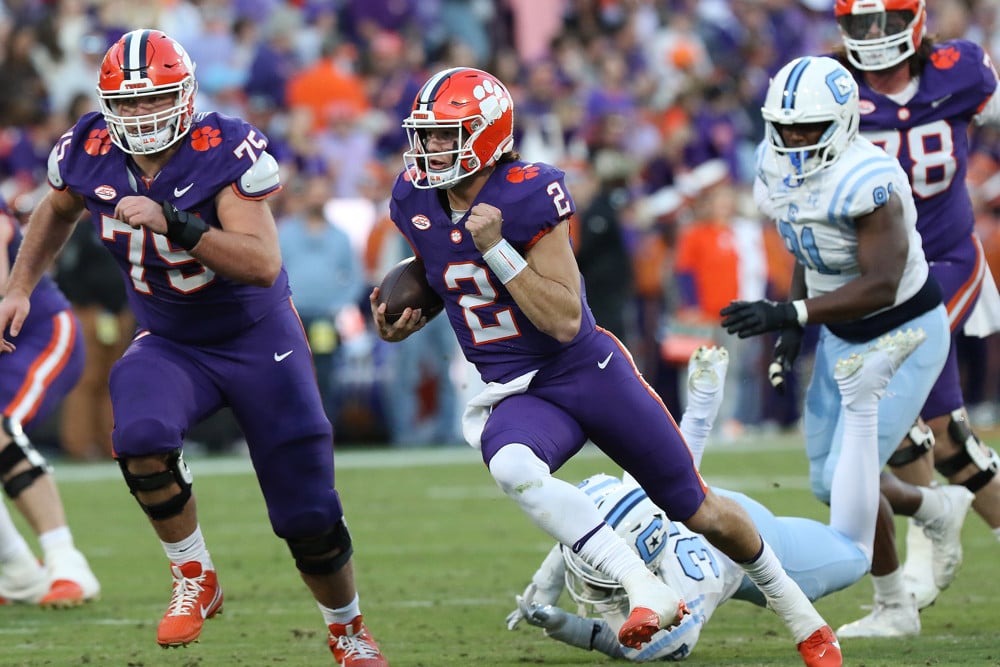When building lineups for college football this fall, keeping these five things in mind can help you build better DFS lineups:
1. Play Exclusively Quarterbacks in the Superflex Position
One of the simplest ways to improve your CFB DFS play is to almost exclusively play quarterbacks in your Superflex position. There are a high number of dual-threat QBs in college football, who have insane ceilings due to concentrated touches, that you will be best served to default yourself to starting with QB at SFLEX. Beyond just the ceiling of the dual-threat QBs, it’s really the floor/ceiling combinations of the QB position overall, relative to RBs and WRs (most teams run deeper rotations at RB and WR than pro teams do), that make them such a priority in all game formats. Obviously contextual factors do arise within a given slate where you may want to consider a non-QB at Superflex, but generally speaking, it’s beneficial to have the mindset that SFLEX is effectively QB2.
2. Don’t Overstack Your Quarterbacks, Especially Mobile Ones
Deciding whether to stack your quarterbacks really depends on a myriad of factors, such as the price of the QB/WR, the skill set of the QB, the rotations of the WRs, matchups, etc. You should never make a hard-and-fast rule to stack your QBs with WRs in college football, but it’s not something you should actively avoid. When looking at the weekly flagship contests on DraftKings in 2022 and 2023, QBs in winning lineups were stacked with at least one pass catcher 74% of the time (leaving 26% of the time the winning quarterback was unstacked) — but only 14.1% of the time the quarterback in a winning lineup was stacked with two pass catchers.
If the QB hits his ceiling outcome, how does that QB reach his ceiling? And what are the ranges of outcomes of his supporting cast relative to their price tags? If you are playing a dual-threat QB in a high-powered offense where they rotate all of the WR positions pretty heavily (and they are overpriced), maybe this is a good place not to stack; just play the QB alone. If you are playing a pocket passer on a team with condensed target volume at discounted price tags, you should definitely stack at least one WR in this spot (in tournaments). To really boil it down: If we are taking a non-mobile QB in a GPP lineup, we generally recommend stacking with at least one pass catcher. However, we typically target mobile quarterbacks for our lineups, and it’s perfectly fine to play a mobile quarterback without a pass catcher.
3. Lean into Volume and Matchup Over Raw Talent
In college football, it is very easy to get caught up in how many recruiting stars this guy has or to focus on his long-term potential as a player. The hype train can get anyone. However, we are playing daily fantasy, so we want to focus on production today, not pro potential for tomorrow. It is nearly impossible to consistently overcome a lack of touch volume in fantasy sports, so we generally want to lean into high-volume situations, in good matchups, over raw talent — especially in cash games and small-field tournaments.
We routinely see highly-rated players and players who play for popular teams, such as Notre Dame, are consistently overpriced. For instance, Notre Dame running back Jeremiyah Love is an extremely talented running back, but he just has not had a workhorse role for his team. Nearly all talent evaluators would say he is more talented than someone like Tahj Brooks, who played for Texas Tech last season. However, Brooks had 286 carries in 11 games (26 per game) and Love had 163 carries in 16 games (10.2 per game). When these two players are similarly priced (which they often were), with similar matchups, the volume deficit is really difficult to overcome when you consider the full range of outcomes. There might be a game or two across the season where Love breaks off two long touchdowns and Brooks gets shut out from the end zone, but long term we are firm believers in volume over talent, especially at the running back position.
4. Embrace the Input Volatility, Especially Early in Season
Since the end of last season, over 2,700 players in FBS have entered the transfer portal. The amount of turnover across each roster is immense, and each year teams are rebuilding large portions of their depth chart with a mixture of returning players, incoming high school recruits, and transfers via the portal. We invest countless hours in attempting to figure out roles and rotations, but sometimes, going into early-season games, even the coaches don’t know who is going to play. Without a formal preseason, teams are often using their first few games to conduct auditions and establish roles.
Early-season uncertainty creates situations with a lot of volatility, and this is often difficult to discern by just looking at the mean projections for each player. You can build an edge for yourself by understanding which situations are volatile. And by leveraging ownership in your favor, you can build high-value tournament lineups. Winning players understand the projections for what they are: just one number (mean) in the range of outcomes of a player’s game. Some players have a more narrow range of outcomes, but those with more input volatility (uncertainty in the number of touches we are projecting) will expand much wider.
As the season progresses, so does our confidence with our inputs, and thus projections are likely going to perform increasingly better as the season ramps up. Take shots on murky situations early in the season, in large-field tournaments especially, and use the uncertainty to your advantage.
5. Plan for Questionable Tags and React to Late News
While injury information is improving each season, especially across the SEC and Big 10, it is still not uniform and delivered in a timely manner like in the NFL. Throughout the season, there will be countless times where late news turns slates on their head, or we have an outstanding questionable tag on a key player. Those who can react the best in these spots are usually rewarded. Noting questionable spots throughout the week and putting together a game plan on how you are going to handle these situations is a beneficial exercise.
Also, when surprise news comes out just before lock or mid-slate, it can be insanely valuable to rebuild lineups because it is something the field is just not doing enough. Most people focus on getting the “out” player removed from their existing lineups, and not enough of the field is swapping their portfolio of lineups in order to actually optimize in response to the news. Rebuilding can be a pain or be somewhat overwhelming, but repetition will sharpen your ability to respond to these situations, which will really improve your DFS play long term.


